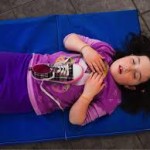American family life is busy and stressful these days. Parents must work harder than ever to make ends meet. Similarly, children’s days are longer, packed with more homework and extra-curricular activities, and less time to play, daydream, and explore the outdoors. “Anxiety” is one of the most common issues faced by children in our time. Younger children may be worried, irritable, or wound up. Many tweens and teens feel “stressed out.”
Fortunately, American society is embracing practices, such as yoga, mindfulness, and meditation, as antidotes to the intense pace of daily life. Common among all these practices is an emphasis on deep breathing to reduce stress. You do not have to be a devoted yogi or go on a silent retreat to practice deep breathing for relaxation. Parents and children alike can learn and draw upon this technique anytime they feel anxious, or just want a brief retreat from the world around them before continuing with the day.
What does breathing have to do with anxiety?
- When we are anxious, we tend to take quick, shallow breaths. While it may be that we are simply running late for school or a meeting, the primitive part of our brains are going into “fight-or-flight” mode. During a full-blown anxiety attack, we may hyperventilate and begin to feel dizzy or faint.
- It is impossible to hyperventilate and breathe deeply at the same time. When we deliberately breathe deeply, we are sending our brains and bodies a signal that it can relax.
Why is deep diaphragmatic breathing for relaxation beneficial?
- When we breathe deeply, we are nourishing our bodies with more oxygen.
- It is a tool that can be used anytime and any place in order to reduce anxiety.
- It is empowering for children who tend to feel anxious and helpless to know that they have a tool for relaxing their bodies, and don’t need to depend entirely on others for relief.
- Relaxation contributes to better sleep, eating, school work, mood and behavior.
- Most people take shallow breaths, expanding their rib cages to expand their lungs. Deeper diaphragmatic or belly breathing creates more space for fuller expansion. It is essentially the opposite of hyperventilating (taking short, shallow breaths), one of the hallmarks of anxiety.
Aren’t we breathing all the time?
How can I teach it to my child?
Basic Breathing for Relaxation:
- Have your child lie comfortably on her back, with limbs loose, arms to the side. Have them can close their eyes if they like.
- Ask them to breathe in through their nose, and then out through her mouth. Ask them to listen to and notice their breathing: how it feels and sounds entering their nose, exiting their throat.
- Now, help them to slow the breathing by counting seconds. “Breathe IN…2…3…4. Now breathe OUT…2…3…4.” You can adjust the time for their comfort. The longer the exhale the better.
- Once they have that down, send their awareness to their belly. With each inhale, their belly should rise like an expanding balloon, and then fall with the exhale. To make the rise and fall more tangible, invite them to place a small stuffed animal or something similar on their belly.
- Other playful tricks for getting a child to slow down and breathe.
- Blow out the candles. Have them hold out their hand with their arm straight and fingers pointing up. Imagine their hand and fingers are a cake with lit candles. Take deep breaths and blow the 5 candles out one by one.
- Flowers and Pinwheels: Have the child hold a pinwheel. First have them pretend it’s a flower, and inhales through their nose to take in the beautiful scent. Then blow out with their mouth, slowly, to spin the petals.
- Breathe in the blue. For kids who struggle with tantrums and anger: have them imagine that they are breathing in cool blue air, and breathing out red hot angry air. They can even use their arms to “gather” the blue air on the inhale, and then push out the hot air on the exhale.
- Add visualization : Have the child imagine a relaxing place while deep breathing. As the child tells you what this place looks like, smells like, feels like, and sounds like so that they fully immerse their mind into this peaceful place. Now on to your breathing exercise.
Additional resources: For more on this subject, check out the “Breath2Relax” App and the relaxation and stress management CDs and books by Indigo Dreams (kids).
Written by Laelia Gilborn, Holds two clinical licenses L.C.S.W. in VA and L.I.C.S.W. from the District of Columbia. Ms. Gilborn also has two Masters Degrees in Social Work and Public Health. She has additional training in child-centered play therapy and other therapeutic approaches to working with children. She has a special interest and experience with supporting families who are coping with health-related challenges and grief and loss issues
